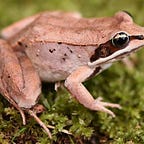Amphibian Advocate — Sword-Tail Newt
In this week’s edition of Amphibian Advocate we’ll be cutting into the pet trade and talking about the Sword-Tail Newt, an endangered species of newt found only in Japan where they are kept as pets, but are on the decline in the wild.
Sword-Tail Newt — Can Conservation Shield the Sword-Tail from Further Loss?
The Sword-Tail Newt (Cynops ensicauda) is a species native to Japan that is commonly kept as a pet, but this means very little for their dwindling wild population. This species, which is classified by the International Union for the Conservation of Nature (IUCN) as “Vulnerable”, has seen significant wild population decrease in recent years as the result of encroaching land development and deadly fungal infection, as well as predation by fish introduced unwisely into their habitat, according to AmphibiaWeb. The few efforts made to revive the wild population of Sword-Tail Newts are not enough to save it from even greater population decrease at the hands of man, but with conservation efforts and awareness increased, they may stand a chance.
Taxonomy
According to Caudata Culture, the Sword-Tail Newt is divided into two subspecies, Cynops ensicauda eniscauda, called the “nominal” subspecies, and Cynops eniscauda popei, both of which are nearly physically identical but call different areas home. Juvenile Sword-Tail Newts have external gills, which they absorb into their bodies in their metamorphosis to adulthood. Adult Sword-Tail Newts are known to be on average between 11 and 14 centimeters (4–5.5 inches) long, with the largest documented male reaching 12.7 centimeters and the largest female reaching 18 centimeters in length. On that note, the Sword-Tail Newt is sexually dimorphic, meaning that the male and female of the species display different physical traits. In the case of the Sword-Tail, the female has a much longer tail than the male, with the typical female Sword-Tail having a tail longer than her body, and the male having a comparatively stubby one. Sword-Tail Newts typically have dark brown backs and a dorsal (spinal) ridge that can be brown or tan, with red-orange bellies marked with dark brown and black spots. The Sword-Tail Newt has a distinctive stripe that runs the length of its body on either side behind its eye, which is sometimes broken up by spotting on its sides.
Habitat and Distribution
The Sword-Tail Newt inhabits an area in the south of Japan called the Ryukyu Archipelago. The Ryukyu Archipelago is a chain of small islands south of the island of Kyushu, known to most as the island where Nagasaki (the site of a World War II American atomic bomb attack) is located. The two subspecies of Sword-Tail are distributed across the islands of the Ryukyu Archipelago with C. e. eniscauda inhabiting a majority of the islands. The climate of the area is subtropical and rainy, which provides conditions conducive to the survival of the Sword-Tail Newt, which needs pools to breed.
Sword-Tail Newts live alongside and in bodies of water across their known distribution area, and are known to be primarily terrestrial in all but their final stage of life. The Sword-Tail Newt requires stagnant or slow-moving water and lives in areas where such pools or streams are in abundance, including in rice paddies and in roadside ditches. In wild populations, males outnumber females and can be very territorial in adulthood, which can mean a dangerous environment for some percentage of the population in places like busy roadways or steep-walled manmade drainage ditches is common.
Conservation Status
As I mentioned in the opening paragraph of this article, the Sword-Tail Newt is listed by the IUCN as “Vulnerable”, which is a categorization the organization gives to flora and fauna that are in significant periods of decline. Such is the case for the Sword-Tail Newt, with the newest research on the species suggesting that their population number and distribution area are shrinking at an alarming rate, with the number of recorded breeding Sword-Tails 25% of what it was 15 years ago at its most recent count according to the IUCN.
The Sword-Tail Newt has no natural predators in its typical habitat, but industrial expansion, land development and deforestation, and general habitat loss due to increasing temperatures have forced populations of Sword-Tail out of their usual homes and into places of peril where they have a significantly lower chance of survival. They are often run over by cars when crossing the road.
A large number of Sword-Tail Newts have been captured for the Japanese pet trade in the last 20 years, and there is a significant captive population of Sword-Tails, with captive breeding occurring to support the keeping of newts as pets across Japan. This can be seen as both a hindrance to wild newts, or as a good thing for their conservation effort. They are hardy enough to be kept and bred in captivity, and endearing oneself to them is an easy thing to do, and so I personally hope that the ongoing pet trade helps bolster the cause of saving their wild population and see no harm in keeping ethically sourced Sword-Tail Newts as pets. Below is a video from German YouTuber AquaTerra-Life showing his pet Sword-Tail Newts feeding on Tubifex worms.
What Can You Do?
By now, I as the writer of Amphibian Advocate have covered sustainability practices, climate change, conservation research, and public mourning as things that you can do to help serve amphibians, but this week I recommend that everyone reading this do some additional reading on the exotic pet trade, a practice that is happening on a small scale with Sword-Tail Newts, but on a much more significant and detrimental scale globally, with hugely negative impacts across the board. This National Geographic article provides everything a newbie to the concept of wildlife trading may wish to know, and is a worthwhile read if you enjoy this blog.
